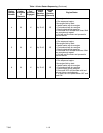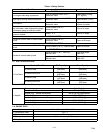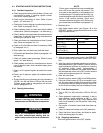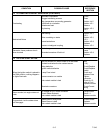
2-- 3
T -343
2.3 STARTING AND STOPPING INSTRUCTIONS
2.3.1 Pre-Start Inspection
a. Check engine lubrication and fuel filters, oil lines, and
connections for leaks. If required, tighten connec-
tions and/or replace gaskets.
b. Check engine lubricating oil level. (Refer to para-
graph 1.10, table entry f.)
c. Check polyV-belt forfraying orcracksand properten-
sion. (Refer to paragraph 4.4.9).
d. Check radiator hoses for leaks and check r adiator
coolant level. (Refer to paragraph 1.10, table entry j.)
e. Checkradiator coiland generator airintakescreen for
cleanliness. If required, clean using compressed air,
reversing the normal air flow.
f. Check air cleaner for cleanliness and clean if neces-
sary. (Refer to paragraph 4.4.13.)
g. Check in--line fuel filter and clean if necessary. (Refer
to paragraph 4.4.4.)
h. Drain water from fuel tank sump and filter bowl.
i. Fillfueltank withdiesel fuel.(Refer toparagraph1.10,
table entry g.)
j. Check air intake heater amperage. (Refer to para-
graph 1.10, table entry h.)
k. Check battery terminals for cleanliness and secure-
ness. If required,clean, thencoat witha battery termi-
nal sealant.
l. Check, and if required, tighten all electrical connec-
tions.
m.Check, and if required, tighten all hardware (brack-
ets, etc.).
n. Ensure that the main generator set circuit breaker is
off (CB-1 for 460 volt units or CB4 for 230 volt units).
Connect power cable to refrigeration unit and pro-
ceed to paragraph 2.3.2.
2.3.2 Starting Instructions
WARNING
Beware of moving poly V-belt, belt driven
components and hot exhaust components.
WARNING
Under no circumstances should ether or
any other unauthorized starting aids be
used inconjunctionwith theair intakeheat-
er.
NOTE
Piston rings in engines that have oper ated less
than 100 hours may not be fully seated. This
may lead to the possibility of oil seepage from
the exhaust pipe. To properly seat the r ings,op-
eratethe engineunderfullload foraperiodof 24
hours. If the condition persists, check valve
clearance w henthe engineis cold. (Refer toen-
gine workshop manual lis ted in paragraph 1.2).
a. Standard Units
1. Hold intake heater switch (see Figure 1-6) in the
PREHEAT position. Suggested hold times for a cold
engine are as follows:
COLD ENGINE PREHEAT TIMES
Ambient Temperature Time
78 F/ 26 C 5 seconds
32Fto78F
(0Cto26C)
10 seconds
18Fto32F
(--8Cto26C)
20 seconds
Below18F/-8C 30 seconds
2. With the intake heater switch held in the PREHEAT
position, place the ignition switch in the START posi-
tion.
3. After the engine has started, continue to hold the in-
take heater switch inthe PREHEAT pos ition until the
engine develops sufficient oil pressure to close the
oil pressure safety switch (approximately 5
seconds). When released, the intake heater switch
will automatically return to the OFF position and the
heater will remain energized for 3 minutes.
b. Units with Auto Start
1. Place the Ignition switch (IGN) in the RUN position.
2. If the l ow coolant sensor (LCS) is immersed in cool-
ant, the auto restart module will energize the heater
for 30 seconds and the safety buzzer will sound. Af-
ter the 30 second delay, the unit will attempt to start.
2.3.3 Post-Start Inspection
a. Turn on CB-1 for 460 volt units or CB4 for 230 volt
units.
b. Check generator output with a voltmeter. In the no
load condition, output should be at 490 ( +/- 10%)
volts with 1800 engine RPM. Place generator set
main circuit breaker in the ON position. Start refrig-
eration unit.
c. Run engine 10 minutes (check total time meter op-
eration).
d. Listen for abnormal bearing noise (AC generator).
e. Check fuel lines, lube oil lines, and filters for leaks.
f. Check exhaust system for leaks.
2.3.4 Stopping Instructions
Place the ignition switch in the OFF position.


















